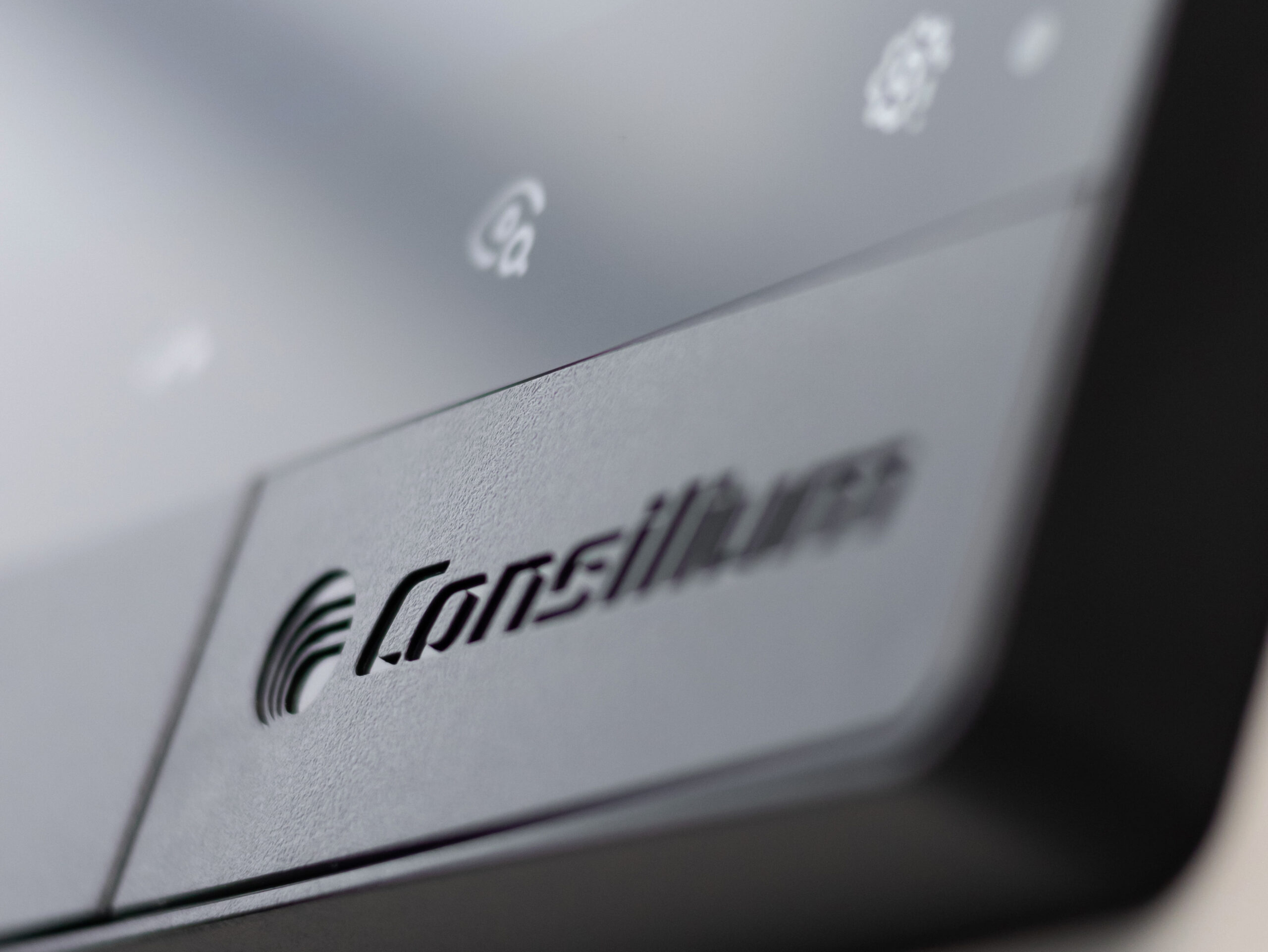
Where proof meets purpose – Consilium’s blueprint for responsibility
At Consilium’s Gothenburg headquarters, two voices in sustainability reflect on the space between what can be measured and what simply matters.
Malin Cardemar, CMCO and Head of Sustainability, speaks without slides or slogans. She gestures as she speaks, tracing the air as if mapping an invisible circuit.
“Sustainability is in everything we do,” she says. “We don’t say it because it sounds good. We say it because lives, and the planet’s future, depend on every decision we make.”
Around her, boards and prototype detectors line the walls, reminders that this is a company where ideas are tested in extreme conditions, including heat and saltwater.
“Fire safety,” she says,” is about prevention — and prevention, when you look closely, is the most sustainable act of all.”
Beside her sits Sharareh Farshchiha and listens, just as focused but with a different gaze, one searching for how it can all be measured.
Where Malin talks about systems and values, Sharareh deals with numbers. As Consilium’s Global Sustainability Manager, she turns vision into action — running the numbers, tracking carbon, translating data into real progress.
“Here, sustainability isn’t an add-on,” says Sharareh, who joined Consilium earlier this year. “Leadership pays attention, there’s a plan, a direction, and we move forward together.”
Where values meet work
That sense of purpose runs through the entire company. In HR, it means working with human rights and equality, diversity and inclusion. In R&D, it means choosing materials that perform, last and waste less, even if they don’t carry the greenest label.
“Sometimes we can’t use the most sustainable material,” Malin says. “It must be a certain type to function safely. But we keep it on the checklist, so we know exactly where we can improve.”
Retrofitting is another decisive shift. “We design systems that can be upgraded,” she says.
Governance follows the same logic. Strict business ethics, supplier responsibility, and a shift towards greener energy have already reduced emissions. “We have clear actions in each area,” Malin says.
When asked for a concrete example, Malin replies, ´A product or a solution? ´. Then she points to Consilium’s remote digital platforms, systems that let technicians connect to ships or buildings from anywhere in the world.
“It means fewer trips for everyone. Fewer flights, less fuel, faster support. That’s lower emissions and better service,” she says. “Real progress you can measure.”
But for Malin, the technology’s deeper value lies in what it prevents. “If you detect an incident even minutes earlier, it can be the difference between a small issue and a disaster”.
When the conversation turns to what makes their products sustainable, Malin gives a brief smile. “By being what they are — and doing what they do,” she says.
Prepared for what’s next
For her, sustainability is a question of adaptation, meeting each new safety challenge with a smarter response. “Look at what’s happening, new fuels at sea, greener materials on land,” she says. “Every shift creates new risks, and that means new solutions. Our job is to stay ahead of them.”
That focus keeps Consilium close to its customers. “We work hand in hand with them,” says Malin. “Every challenge is a chance to build something smarter and safer.”
She mentions a new flame detector with a 160-metre range for large industrial sites. “It’s all driven by safety needs that evolve with new technologies.
Electric vehicles are an example. “A parking garage for electric cars or buses needs new kinds of detection and warning systems,” she says. “We’re working closely with those challenges, how to detect an EV fire early, even down to the smallest spark.”
Next to her, Sharareh listens intently. Where Malin talks about evolving risks, Sharareh’s focus is on tracing their environmental impact.
One of Sharareh’s priorities is the supply chain. “We’re assessing our suppliers to see how they actually work with sustainability,” she says. “Everyone signs our Code of Conduct, but we want to go beyond the paperwork.”
That means action over promises. “We’re mapping where they stand, how much they cut emissions, how much renewable energy they use, and then we keep the conversation going,” she explains. “The goal isn’t just to tick boxes. It’s to help them reach the level we’re aiming for.”
Her biggest challenge? The maths. “Measuring impact sounds simple,” she says.” But sometimes the data just isn’t there.”
She counts: “Old systems. New suppliers. Different levels of experience, these gaps take time to close.”
Her approach is to stay patient, stay structured. “It’s about teamwork across departments and constant dialogue with suppliers,” she says. “Not everyone is at the same level yet. So, we move one step at a time.”
When the numbers aren’t there, the work doesn’t stop. “We can use estimates, that’s completely acceptable within sustainability standards,” Sharareh explains.
“We document the methodology and compare consistently until we can measure more accurately. As long as we’re transparent about how we did it, it helps us understand where we are and then become more mature step by step.”
She laughs when I tell her it’s interesting. “I’m glad you think so,” she says. “Usually when I start talking about data, people just look at me and ask what I’m talking about.”
Ask Sharareh where safety and sustainability clash, and she doesn’t even pause. “In some industries, sure, that tension exists,” she says. “But for us, safety is sustainability. The better the product, the safer it gets.”
She leans forward. “Of course, there are choices, like when you want to use recycled plastic or a softer material. But if it hurts performance, we stop right there. You can’t trade safety for a greener label. That’s when our engineer’s step in — they test, prove, and make sure every solution still protects.”
Meaningful targets
At the mention of ongoing projects, Sharareh’s face brightens. “SBTi,” she says.
She laughs at my blank stare. “Science-Based Targets initiative, a framework for setting climate goals grounded in science”.
She explains that it is a way to set targets for Scope 1, 2 and 3 emissions. It provides direction and guidance on how much their business should reduce each year to reach net-zero goals.
“It’s exciting because it’s not just a technical roadmap; it builds a mindset. Once you commit publicly, the whole organisation feels a sense of responsibility. It’s a step further, a collective commitment.”
At the heart of it all
The talk shifts from big plans to what keeps operations safe, year after year.
“Our products have a long lifetime,” says Malin. “Some people joke they last too long.”
That longevity is by design. Instead of replacing whole systems, Consilium upgrades only what’s essential. Key components get a modern update, while cables, sensors, and detectors stay as long as they work.
“We replace what’s needed, but we don’t waste what still works. If a system is twelve years old, retrofitting will keep its quality for at least another twelve.”
It’s hard to argue with the logic: less waste and a smaller environmental footprint by avoiding new production.
She goes on to describe the SMiG system, a network of sensors and cameras designed to detect danger minutes earlier than before.
“What I’d really like,” she says, “is to know what those minutes are worth. For the customer, it’s safety and value. But what about the planet? What does it mean, in real terms, when a fire or gas incident never happens?”
Sharareh jumps in. “We can model the scenarios. Depending on where the technology is used and the type of fire we’re preventing, we can calculate its impact. And compare emissions or outcomes with and without the solution. Even those few seconds, those few minutes, they can be quantified.”
For a few moments, they forget anyone else is in the room. They build on each other’s thoughts, one talking in stories, the other in data, energy bouncing back and forth like a live circuit.
Still, some of Consilium’s most meaningful results will never fit into a spreadsheet. They may never capture the moment when a fire is averted, a life is saved, or an emission that never occurs.
“The earlier we can detect, the better we can prevent,” says Malin. “And that, in the end, is responsibility. It’s what drives us. It’s built into every product — preserving, protecting, creating long-term value for life itself.”
Sharareh smiles, nodding, “Not everything can be measured,” she says. “But responsibility is always part of our equation. It’s what matters most.”
Read more about our sustainability work here.
Talk safety with us
There are thousands of questions regarding safety. But there are also thousands of answers. Talk safety with us – we are ready when you are.


